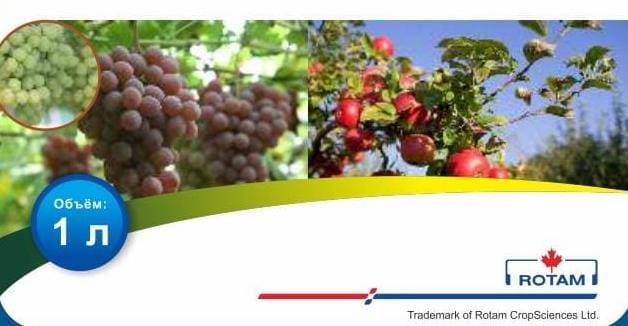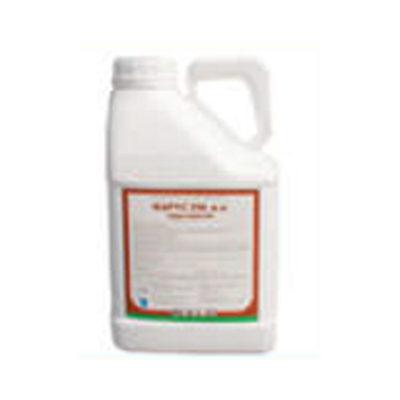Restrictions on transportation, use and storage of the pesticide: It is forbidden to use it in personal subsidiary plots. Aircraft use is prohibited. In accordance with paragraphs. 6 paragraph 15 of article 65 of the “Water Code of the Russian Federation” (as amended by Federal Law-282 dated 10/21/2013), the use of the drug in the water protection zones of water bodies, including their special case – fish protection zones, is prohibited.
Due to teratogenicity, work with the product should only be carried out by plant protection specialists or under their supervision, or by persons who have undergone special professional training. It is necessary to comply with the requirements and precautions in accordance with SanPiN 1.2.2584-10 “Hygienic requirements for the safety of testing, storage, transportation, sale, use, neutralization and disposal of pesticides and agrochemicals” (M., 2010) respiratory, vision and skin protection.
Store at -18°C to + 35°C.
Recommendations for the protection of useful objects of flora and fauna (including the hazard class for bees with decoding): 1 hazard class (highly dangerous compound) for bees, restrictions within the framework of the existing “Instructions for the Prevention of Poisoning of Bees with Pesticides” (M., Gosagroprom USSR, 1989 ) and compliance with environmental regulations:
- adding repellents or changing the application schedule (term, cultures, frequency of processing, etc.)
- inadmissibility of processing fields littered with flowering weeds (3 plants per m 2 ).
- mowing flowering weeds along the perimeter of the cultivated field to the distance of possible drift of the pesticide;
- processing plants in the evening after sunset;
- at a wind speed of not more than 1-2 m/s;
- border protection zone for bees at least 4-5 km;
- restriction of the summer of bees – at least 4-6 days or removal of bee colonies from the processing area for a period of more than 6 days.
Mandatory advance notification of local public and individual beekeepers (by means of print, radio) 4-5 days in advance about the nature of the plant protection product planned for use, the timing and areas of its application.
The use of the product is associated with high risks for aquatic organisms and low risks for soil microorganisms and earthworms.
Hazard class : Hazard class 2 (highly dangerous compound).
First aid in case of poisoning: At the first sign of malaise, immediately stop work, remove the victim from the area of exposure to the drug, carefully remove clothing and personal protective equipment, avoiding contact with the drug on the skin, immediately seek medical help.
In case of accidental ingestion, rinse the mouth with water, immediately give the victim several glasses of water with a suspension of activated carbon to drink at the rate of 1 g of sorbent per kg of body weight, and then induce vomiting by irritation of the posterior pharyngeal wall. This should be repeated several times to more completely remove the drug from the body (vomiting is caused in conscious victims), then again drink a glass of water with activated charcoal (1 per kg of body weight) and immediately consult a doctor.
If inhaled, remove victim to fresh air.
In case of contact with the skin, remove the drug with a piece of cloth, cotton wool or soft paper, avoiding rough rubbing of the skin, and then wash the contaminated area with soap and water.
In case of contact with clothing – after removing contaminated clothing or shoes, rinse with water areas of possible skin contamination.
In case of contact with eyes, rinse eyes immediately with a soft stream of clean running water.
After giving first aid, if necessary, seek medical attention.
There are no antidotes, treatment is symptomatic, barbiturates and benzodiazepines are not recommended.
Phone number and address for emergency contact in case of poisoning: For consultations in case of emergency in case of poisoning, you should contact the Federal State Institution “Scientific and Practical Toxicological Center of the Federal Medical and Biological Agency of Russia” at the address: 129090, Moscow, Sukharevskaya Square, 3, bldg. 7 or by phone tel. (495) 628-16-87, (495) 621-68-85 (24/7).
Storage conditions: the drug should be stored in warehouses specially designed for the storage of pesticides, in a dry and cool well-ventilated area away from food, feed, medicines, seeds, household chemicals. A prerequisite is the preservation of the tightness of the factory packaging and the container label. Storage temperature -18°C to +35°C.
Shelf life – 3 years
Warranty period of storage – 3 years
Party N:
Date of manufacture:
Volume (l) – 1l
Маркировка:
ОПАСНО!/DANGER!
Способы обезвреживания пролитого или рассыпанного пестицида: При случайной утечке препарата необходимо изолировать опасную зону и преградить доступ к ней посторонних. Соблюдать меры пожарной безопасности. Использовать защитную одежду и средства индивидуальной защиты. Пострадавшим оказать первую помощь. Сообщить местным органам исполнительной власти о чрезвычайной ситуации. Прекратить утечку препарата и произвести перезатаривание в плотно промаркированные контейнеры.
Разлитый препарат необходимо засыпать сорбентом, песком, опилками или землей. Загрязненный сорбент и почву обезвредить 7% кашицей свежегашеной хлорной извести, собрать в промаркированные контейнеры, организовать их безопасное хранение с последующим удалением в места, согласованные с территориальными природоохранными органами и управлениями Роспотребнадзора.
Загрязненную землю перекопать на глубину штыка лопаты.
Во избежание самовоспламенения не допускается засыпать место пролива сухой хлорной известью.
При значительной разливе следует направить сток в подходящий контейнер, не допуская слив в поверхностные водоемы, канализацию. При дорожно-транспортном происшествии – приостановить движение транспортных средств, обозначить место пролива препарата предупредительными знаками и действовать в соответствии с требованиями аварийной карточки.
Методы уничтожения или утилизации пестицида: Не сливать остатки рабочего раствора в канализацию, реки и другие водоемы. Полностью выливать содержимое тары в резервуар опрыскивателя и другого оборудования для внесения. Отходы препарата подлежат сбору и вывозу в места, отведенные экологами и органами Госсанэпиднадзора.
Мероприятия проводятся в соответствии с “Временной инструкцией по подготовке к захоронению запрещенных и непригодных к применению в сельском хозяйстве пестицидов и тары из-под них ” (ВНИПИагрохим, Рязань,1989г.)
Методы уничтожения тары из-под пестицида: Не допускается вторичное использование тары для хозяйственных нужд. В соответствии с требованиями Временной инструкции по подготовке к захоронению запрещенных и непригодных к применению в сельском хозяйстве пестицидов и тары из-под них», ВНИИПИагрохим, Рязань, 1989 г.
Рекомендации о транспортировке, применении и хранении пестицида прилагаются
Номер государственной регистрации пестицида: 102-01-2019-1
Регистрационный номер тарной этикетки: 363-01-2019-1-18-6686






Reviews
There are no reviews yet.